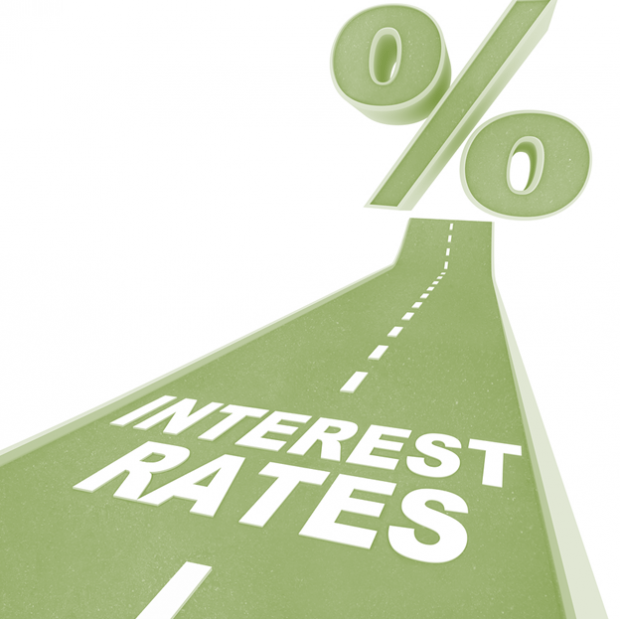For each 1 percentage point rise in interest rates, the value of bonds held by the U.S. property/casualty insurance industry will decline by about $40 billion, representing roughly 7 percent of industry capital, Moody’s Investor’s Service reports.
Moody’s provides the estimates of fixed-income declines and capital impacts corresponding to a 1 percentage point increase, or 100 basis point rise in interest rates, in a research report published on Thursday.
The rating agency bases its estimates on a review of Securities and Exchange Commission filings for P/C carriers rated by Moody’s with a weighted average fixed income portfolio duration of 4.3 years, assuming a typical P/C mix of treasury, municipal and corporate bonds.
While Moody’s central economic scenario projects an 80 basis point rise over the next year, and 130 basis points over the next two years, Moody’s says that a stressed scenario—a sudden rate spike of 300 basis points in the next 12 to 18 months—could produce unrealized losses of roughly $120 billion across the industry, or 20 percent of policyholders’ surplus.
 Actually, P/C carriers are challenged whether interest rates move up or down, Moody’s notes in the Special Comment report titled “P/C Insurance Interest Rate Challenges: Capital Volatility If Rates Keep Moving Up, Lackluster Returns If Rates Stay Low.”
Actually, P/C carriers are challenged whether interest rates move up or down, Moody’s notes in the Special Comment report titled “P/C Insurance Interest Rate Challenges: Capital Volatility If Rates Keep Moving Up, Lackluster Returns If Rates Stay Low.”
The P/C insurance sector holds about $900 billion of bonds, which leaves it highly exposed to fixed-income market developments.
“If rates continue moving up, which we believe is the more likely scenario, companies will face capital volatility as bond prices decline. If rates stay low or resume their long-term downward trend, earnings will be pressured by weak investment income,” says the report’s author, Paul Bauer, vice president—senior credit officer, in a statement released with the report.
Even with interest rates at historic lows, investment income represented 200 percent of pretax income for the industry over the last five years, Moody’s estimates. (The industry had losses on the underwriting side in four of the last five years.)
The report also notes that while rising investment rates would boost investment income and industry profits over time, they might also put the brakes on insurance pricing momentum.
Moody’s central economic scenario of an 80 basis point interest rate rise results in a pretax bond value decline of just over $30 billion by Moody’s calculations, equivalent to about 5 percent of overall industry surplus.
The report includes charts displaying estimated durations and capital losses corresponding to a 100 basis point interest rate rise for more than two dozen P/C individual carriers (based on data from SNL Financial LLC). For most carriers, the expected capital declines coinciding with the 100 basis point jump scenario range between 5 and 15 percent of shareholders’ equity (on a GAAP basis). Only four carriers show capital hits above the 15 percent level: Horace Mann, American Financial, CNA and Hartford.
Bauer notes that all four of these companies (and, in fact, all the carriers coming out on the high side of the range) are multiline companies that have large life insurance or long-term care operations. That means “they end up with higher duration than a typical P/C company,” but potential fixed-income volatility is less worrisome for these multilines because long-dated liabilities are well matched to assets, he says.
Other key takeaways from the Moody’s report are:
- The risk of market value declines is moderated by strong liquidity at insurance operating companies, the industry practice of holding bonds long term and the unlikely need to liquidate investment portfolios.
- Rising interest rates combined with higher than expected claims inflation could be especially problematic for P/C insurance companies given that lower asset valuations would be accompanied by increases in loss reserve liabilities.
- Continued low interest rates—a less likely scenario from Moody’s perspective—would be easier for P/C insurers to manage because of the lag time between interest rate declines and their impact on overall portfolio yield. The lag gives carriers time to react by raising insurance premiums to offset declining investment income.
- Moody’s estimates that if interest rates were to stay close to first-quarter 2013 levels for the next five years, the industry would see a $16 billion reduction in investment income, which could be replaced by a 3.6 point average improvement in the combined ratio (with needed improvements greater for commercial than for personal lines insurers).
- Insurers have modestly increased investment risk in recent years, allocating more of their investment portfolios to equities and nearly doubling investments in hedge funds and private equity funds over the last five years.
From a credit perspective, the report notes that the low interest rate environment may have benefited the industry in recent years—supporting underwriting discipline and capital adequacy.
“Insurance companies are not likely to fail because investment income is lower than expected,” the report concludes, citing aggressive underwriting and catastrophic losses as bigger threats to solvency.





















 Breaking: Andersen to Replace Zaffino as CEO of AIG on June 1
Breaking: Andersen to Replace Zaffino as CEO of AIG on June 1  Slideshow: Carrier Management’s 2025 Top Editor’s Picks (Unlocked)
Slideshow: Carrier Management’s 2025 Top Editor’s Picks (Unlocked)  California Workers Comp Combined Ratio for 2024 Highest in 20-Plus Years
California Workers Comp Combined Ratio for 2024 Highest in 20-Plus Years  Five AI Trends Reshaping Insurance in 2026
Five AI Trends Reshaping Insurance in 2026 
